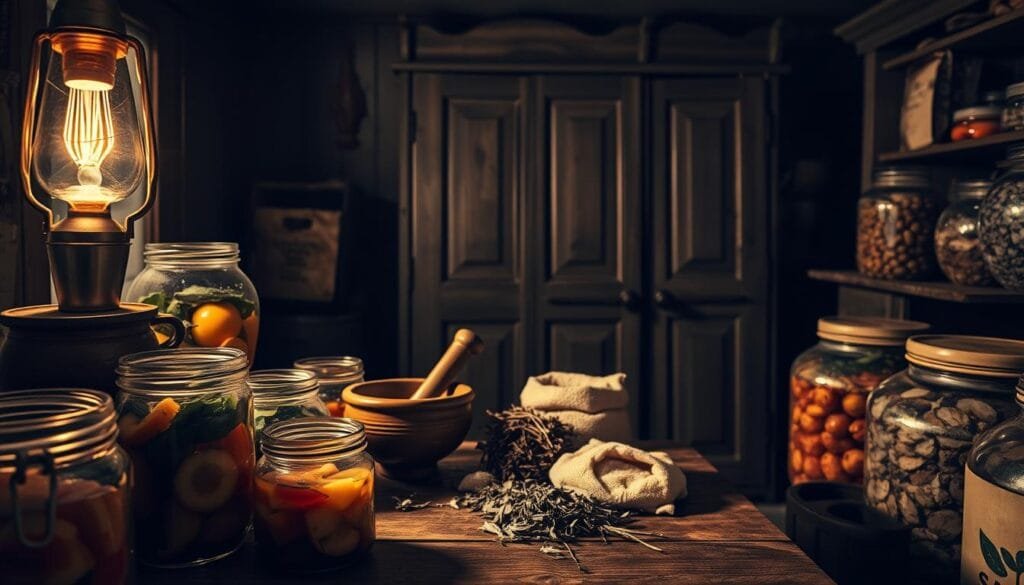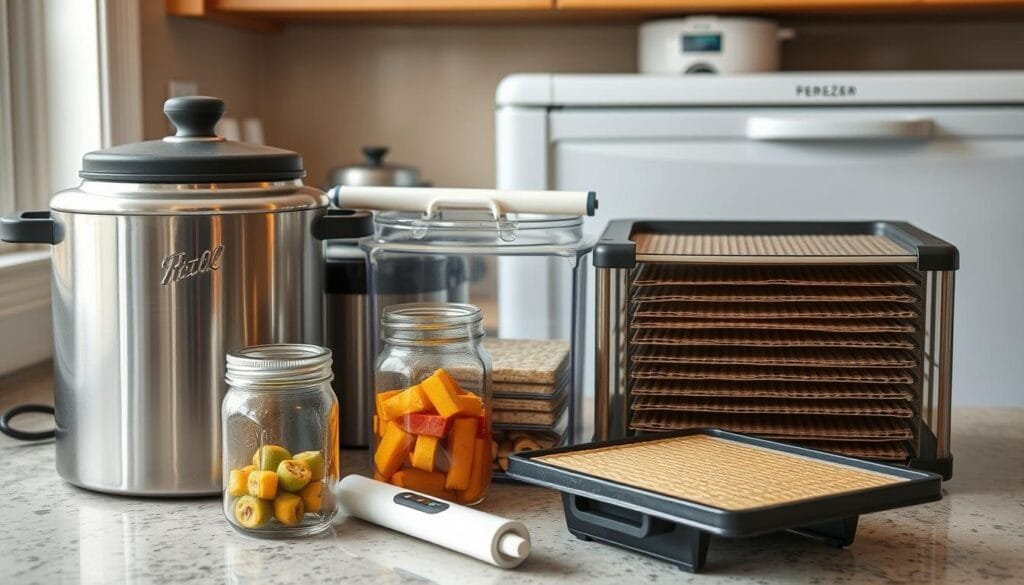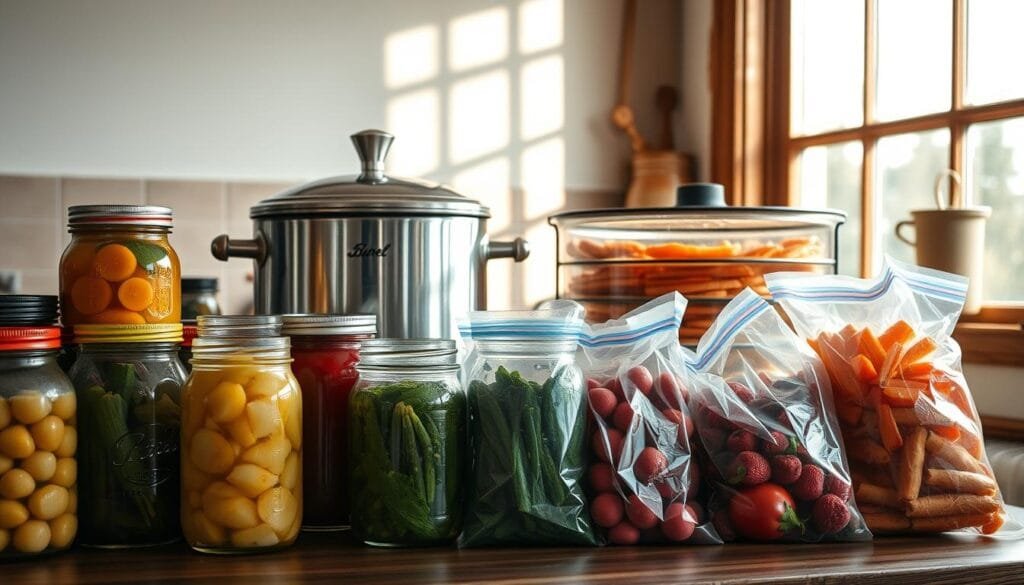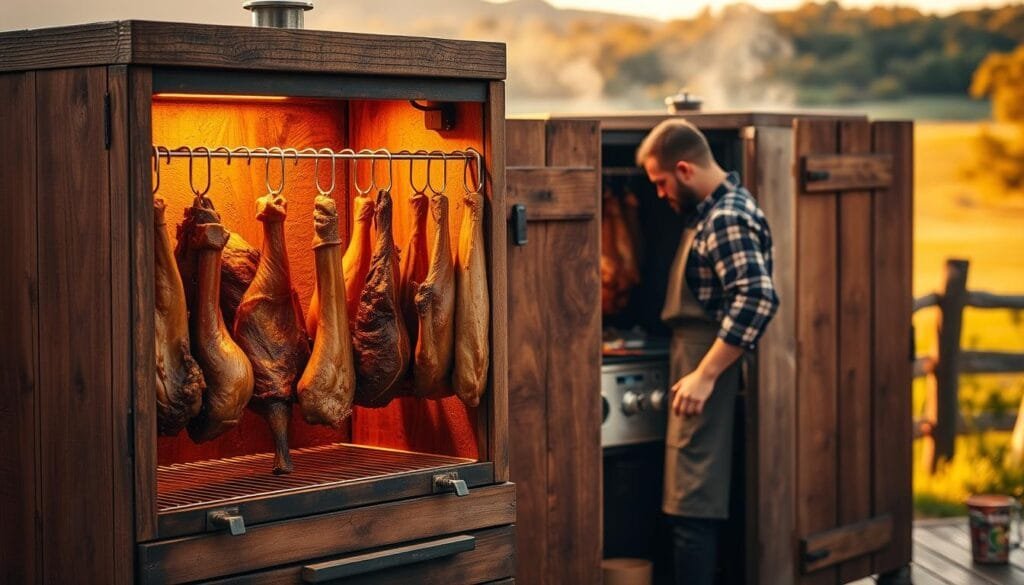Preserving food is a key survival skill that’s been around for ages. It’s not just old-fashioned—it’s useful today too. It can help you save money, cut down on waste, and keep food safe during emergencies.
For centuries, people have found clever ways to keep food fresh. These methods helped communities get through tough times when food was scarce. They made sure everyone had enough to eat.
There are many ways to keep food fresh, like drying, salting, fermenting, and canning. These methods help keep fruits, veggies, meats, and more good for longer. By learning these skills, you can make your own tasty, long-lasting food.
Key Takeaways
- Food preservation helps reduce waste and save money
- Multiple methods exist for storing food without refrigeration
- Traditional techniques remain relevant in modern kitchens
- Preservation methods can improve food’s flavor and nutritional value
- Learning preservation skills increases household food security
Understanding Traditional Food Preservation Methods
Food preservation has been key for humans for ages. Our ancestors found clever ways to keep food fresh without refrigerators. They did this to survive tough times and keep food tasty and nutritious.

Historical Preservation Techniques
Different cultures used their own ways to preserve food. They based these methods on their surroundings and what they had. Some main ways included:
- Salt curing for meat preservation
- Fermentation of vegetables and dairy
- Smoking meats and fish
- Drying fruits and herbs in the sun
- Underground storage in root cellars
“Preservation is not just about extending food’s life, but about maintaining its essence and nutritional value.” – Traditional Food Wisdom
Why Modern Preservation Matters
Even with new tech, old ways of preserving food are important. How to preserve your food without fridge methods have many benefits:
- Reduces food waste
- Saves electricity
- Maintains nutritional integrity
- Connects us to ancestral knowledge
Basic Principles of Food Storage
Understanding food preservation means knowing some key science. Stopping bacteria from growing is key. Bacteria can grow fast, doubling every 20 minutes, turning one cell into 70 billion in 12 hours.
Important factors in keeping food fresh include:
- Controlling moisture levels
- Managing temperature
- Minimizing air exposure
- Using appropriate preservation techniques
Essential Equipment for Food Preservation

Choosing the right tools can make your food preservation efforts top-notch. My kitchen is now a food preservation hub thanks to a few key gadgets. These tools make it easy and quick to save fresh produce.
The most important tools for food preservation are:
- Mason jars with tight-fitting lids
- Vacuum sealer
- Dehydrator
- Pressure canner
- Digital kitchen scale
Quality preservation equipment can save you money. Studies show the average household saves about $500 annually by preserving food at home. With 75% of households using some form of food preservation, these tools are becoming must-haves.
| Equipment | Average Cost | Preservation Capability |
|---|---|---|
| Vacuum Sealer | $50-$200 | 1-3 years storage |
| Dehydrator | $70-$300 | 1-2 years storage |
| Pressure Canner | $100-$250 | 1-5 years storage |
When picking preservation equipment, think about your budget, space, and the food you want to save. Remember, using the right techniques is just as key as having the right tools. This ensures your food stays safe and tastes great.
How to preserve your food without fridge : Canning, Freezing, and More
Learning to preserve food without a fridge is key for saving money and having healthy meals ready. It’s great for those watching their budget or preparing for emergencies. Knowing how to can and freeze food can change your kitchen game.

Preserving food is more than just a survival trick. It keeps food fresh and cuts down on waste. I’ll show you the best ways to keep food fresh without a fridge.
Selecting Quality Produce
Choosing the right produce is vital for preserving food well. Look for:
- Fruits and vegetables at peak ripeness
- Produce free from bruises or soft spots
- Fresh, locally sourced items when possible
“The secret to great preserved food is starting with the highest quality ingredients.” – Preservation Expert
Preparation Guidelines
Proper preparation is key for safe and long-lasting food. Here are important steps for canning and freezing:
- Clean all produce thoroughly
- Cut into uniform pieces
- Blanch vegetables before freezing
- Use sterilized containers for canning
Storage Container Options
Choosing the right containers is important for preserving food. Consider these options:
- Glass mason jars for canning
- Vacuum-sealed bags for freezing
- Airtight plastic containers
Using these preservation methods, you can keep food fresh and tasty for months. Preserved meals can cost as little as 75 cents per serving. This makes it a smart choice for families on a budget.
Smoking and Salt Preservation Techniques

For thousands of years, preserving food has been key to human survival. Smoking meats is a traditional and effective way to keep food safe and tasty. It lets us enjoy food for longer without needing refrigerators.
Cold smoking is a gentle way to preserve food, keeping it below 100°F. It takes 1-5 days and is great for:
- Fish
- Meats
- Cheese
Salt preservation is another amazing way to store food. Salting creates a barrier that stops bacteria from growing. There are two main ways to salt food:
- Dry Salting: Rubbing a thick salt layer on food
- Brine Method: Soaking food in saltwater
When smoking meats, it’s important to follow safety rules. Make sure to control the temperature well and use clean, quality ingredients. The aim is to keep food fresh longer and make it taste better.
Proper food preservation requires patience, attention to detail, and respect for traditional techniques.
Different foods need different preservation methods. Some might need longer smoking times, while others need specific salt levels. Always look up the right method for each food you want to preserve.
Dehydrating Foods: A Complete Guide
Dehydrating produce is a great way to keep food fresh for a long time. It removes moisture, making food last longer. This method is perfect for snacks on the go or for emergency food.
Dehydrating food has many benefits. I’ll share the key techniques and tips for drying food at home.
Best Foods for Dehydrating
Not all foods dry well. Here are the best ones:
- Fruits: Apples, bananas, berries, and peaches
- Vegetables: Tomatoes, peppers, carrots, and zucchini
- Herbs: Basil, oregano, thyme, and rosemary
- Meats: Lean beef, chicken, and turkey
Temperature and Timing Guidelines
Getting the temperature right is important for drying food. Here are some guidelines:
| Food Type | Temperature | Approximate Drying Time |
|---|---|---|
| Fruits | 125-135°F | 6-12 hours |
| Vegetables | 125-135°F | 4-12 hours |
| Herbs | 95-110°F | 2-4 hours |
| Meats | 160-165°F | 6-12 hours |
Storage Methods for Dried Foods
Storing dried food right is important. Use:
- Airtight glass containers
- Vacuum-sealed bags
- Oxygen absorber packets
- Cool, dark storage areas
Pro tip: Always label your dried foods with the date of preservation to track freshness!
Underground Storage Solutions
Root cellaring is a traditional way to keep food fresh without refrigeration. It’s a method that can help you keep vegetables fresh for months. Let’s explore how underground storage can change your food preservation game.
Underground storage uses the earth’s natural temperatures and humidity. It’s about creating a space that’s like a root cellar:
- High humidity (but not dripping wet)
- Consistent cool temperatures
- Proper air circulation
- Protection from direct sunlight
Different veggies need different storage methods. For example, carrots, parsnips, and beets do well in damp sand in crates. The goal is to keep moisture without causing rot.
| Vegetable | Storage Method | Estimated Shelf Life |
|---|---|---|
| Carrots | Damp sand layers | 4-6 months |
| Potatoes | Dark, cool area | 3-5 months |
| Beets | Humid environment | 3-4 months |
Modern tweaks like tater holes—buried metal drums—also work well. They’re great for keeping pests out. By learning about root cellaring, you can save your harvest and cut down on food waste.
Fermentation and Pickling Methods
For centuries, people have used fermentation and pickling to keep vegetables fresh. These methods not only make food last longer but also add tasty, tangy flavors. They make our meals more enjoyable.
Fermentation turns regular vegetables into foods full of good bacteria. This happens when helpful bacteria break down carbs, making the food acidic. This acidity stops bad bacteria from growing.
Basic Fermentation Process
To pickle vegetables, follow these steps:
- Choose fresh, quality produce
- Make a saltwater brine
- Soak vegetables in the brine
- Let it ferment at room temperature
Popular Pickle Recipes
Some favorite fermented veggies are:
- Dill pickles – tangy cucumber pickles
- Sauerkraut – fermented cabbage with probiotics
- Kimchi – spicy Korean fermented veggies
Safety Considerations
Fermentation is simple, but cleanliness is key. Use clean tools, check on the ferment, and watch for spoilage. Fermentation usually takes 3-5 days at room temperature before you need to refrigerate it.
Remember: A good ferment smells sour but not bad.
Learning these pickling techniques helps you keep veggies fresh and healthy. You’ll also make foods that are good for your gut and add flavor to your meals.
Canning Methods and Safety
I’ve learned that canning is a powerful way to preserve food, dating back to 1795. It has become a safe and cost-effective method for storing food.
There are two main canning techniques for food safety:
- Water Bath Canning: Ideal for high-acid foods
- Pressure Canning: Essential for low-acid foods
Water bath canning is great for fruits, pickles, jams, and jellies. For tomatoes, adding bottled lemon juice or citric acid is necessary. Pressure canning is key for vegetables, meats, and soups, reaching 240°F to 250°F to kill bacteria.
| Canning Method | Temperature | Suitable Foods |
|---|---|---|
| Water Bath | 212°F | Fruits, Pickles, Jams |
| Pressure Canning | 240-250°F | Vegetables, Meats, Soups |
Safety is key in food preservation. Always test your pressure canner’s dial gauge yearly and follow the latest canning guidelines. The two-part lid introduced in 1950 greatly improved safety, reducing foodborne illness risks.
Less than 3 people die each year from foodborne botulism. Only a small part of these cases are from home-canned food, if proper techniques are used.
Natural Preservation Using Honey and Oil
For a long time, people have used honey and oil to keep food fresh. These old methods help keep food good for longer. They also keep the food’s taste and nutrients.
Honey is a great preservative because it kills off bad bacteria. It has very little water and lots of sugar. This makes it hard for bacteria to grow. So, honey is perfect for keeping fruits and some veggies fresh.
Foods Perfect for Oil Preservation
Oil is another way to keep food fresh. It works well if done right. It stops food from getting damaged by air and bacteria. Here are some foods that work well with oil:
- Herbs and garlic
- Sun-dried tomatoes
- Artichoke hearts
- Soft cheeses
Honey Preservation Techniques
To use honey to preserve food, follow these steps:
- Choose fresh, high-quality food
- Make sure the food is fully covered in honey
- Use clean, sterilized containers
- Keep it in a cool, dark spot
Important safety note: Always refrigerate honey-preserved foods. Eat them within a few weeks to avoid botulism risks.
Learning about these preservation methods lets you keep your favorite foods fresh. You can use natural ways that have been around for ages.
Root Cellaring Basics
Root cellaring is a time-tested way to keep food fresh. It’s a method that doesn’t need modern refrigeration. Instead, it uses natural cooling to keep vegetables and fruits fresh for months.
To succeed in root cellaring, you need to know the right conditions. Aim for a temperature of 32-40°F and humidity of 85-95%. These levels create the perfect storage for many vegetables.
- Best vegetables for root cellaring:
- Potatoes (6-8 months storage)
- Carrots (4-6 months storage)
- Beets (3-4 months storage)
- Parsnips (4-6 months storage)
You don’t need to build a big structure for a root cellar. You can use a basement corner, build underground, or even a garage space. The main thing is to make it cool, dark, and well-ventilated.
Here are some key tips for root cellaring:
- Cure vegetables before storing them
- Check for spoilage regularly
- Keep the temperature and humidity steady
- Use shelves that let air circulate
Root cellaring not only saves food but also energy. It’s a green way to preserve food, connecting us to old traditions.
Vacuum Sealing and Long-term Storage
Vacuum sealing has changed how we keep food fresh. It removes air, stopping food from spoiling. This keeps your favorite foods good for longer.
The science is simple. Without air, bacteria and oxidation don’t grow. Dehydrated foods can stay fresh for 1-2 years when sealed. It’s great for storing food for a long time.
- Ideal for preserving various food types
- Reduces food waste
- Maintains food color, texture, and flavor
- Prevents freezer burn
Choosing the right vacuum sealer is key. Prices vary from $17 for handheld to $50 for advanced models. FoodSaver offers many options with different bag sizes.
| Food Type | Vacuum Sealing Shelf Life |
|---|---|
| Dehydrated Foods | 1-2 years |
| Fresh Meats | 3-4 years |
| Nuts and Seeds | 1-2 years |
When vacuum sealing, follow food safety tips. Watch moisture levels and use oxygen absorbers for dry goods. Vacuum sealing can greatly improve your food storage.
Alternative Cooling Methods
Exploring ways to keep food fresh without a fridge is key. I’ve found several cool methods to keep your food fresh and safe. These work in different places.
Keeping food fresh without a fridge needs creativity and knowing natural cooling tricks. These tricks can make your food last longer and stop it from going bad.
Zeer Pot Cooling Technique
The zeer pot uses old cooling tech based on evaporation. It’s cool but needs a lot of upkeep. It’s best in very dry, hot places. My research shows it might not work everywhere.
- Works best in arid regions
- Requires frequent water replenishment
- Limited cooling capacity
Natural Cooling Solutions
Look into different cooling ways to keep food fresh without a fridge. Each method has its own benefits, depending on where you are and what you have.
- Underground storage
- Night air cooling techniques
- Running water preservation
- Spring house methods
| Cooling Method | Temperature Range | Effectiveness |
|---|---|---|
| Root Cellars | 32°F – 40°F | High (up to 6 months) |
| Zeer Pot | 50°F – 60°F | Moderate |
| Underground Storage | 45°F – 55°F | Good |
Picking the best cooling method depends on your climate, what you have, and what food you want to keep. Try different methods and watch how they work to find the best one for you.
Preserving Different Food Types
Learning about food preservation is key. Each food type has its own needs. Knowing how to keep food fresh without a fridge is important.
Let’s look at how to preserve different foods:
- Fruits: High-acid foods like berries can be preserved using sugar and citric acid
- Vegetables: Require blanching before freezing to maintain nutritional content
- Meats: Need careful handling and specific preservation techniques
- Dairy Products: Challenging to preserve without refrigeration
My grandfather once told me about preserving caribou meat. He kept it in cold lake water each night. This shows the creativity in preserving food.
| Food Type | Preservation Method | Estimated Shelf Life |
|---|---|---|
| Root Vegetables | Cool, frost-free storage | Up to 1 year |
| Fruits | Canning with sugar | 1 year |
| Fermented Foods | Salt brine fermentation | 6 months |
For successful preservation, consider moisture, acidity, and storage containers. Mastering these can greatly extend food’s shelf life.
Safety Tips for Food Preservation
- Follow USDA Guidelines: Stick to tested, approved recipes and methods for canning and preserving.
- Use Clean Equipment and Containers: Sanitize everything that comes into contact with your food.
- Check Regularly for Spoilage: Look for off smells, bulging lids, or mold before consuming.
- Label Everything with Dates: Clearly mark jars and containers with contents and the date preserved.
Conclusion
Learning to preserve food without a fridge is more than a skill. It opens doors to self-sufficiency and sustainable living. This guide has shown you various ways to keep food fresh, cut down on waste, and save money. Plus, you can enjoy homemade foods all year.
Experimenting is key. Different methods suit different foods. For example, canning can keep food for up to a year. Fermentation can last from 4 to 18 months. Start small and grow your skills over time.
Mastering these methods means more than just storing food. It’s about building a strong nutrition plan. Imagine having homemade pickles, dried fruits, or canned veggies at your fingertips. The joy of knowing what’s in your food is unmatched.
Remember, the more you practice, the better you’ll get. Each try teaches you something new. Keep exploring, stay curious, and enjoy the tasty fruits of your labor. Your pantry will be grateful!
